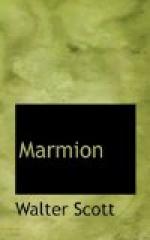’By this arrangement I obtained the survivorship of an office, the emoluments of which were fully adequate to my wishes; and as the law respecting the mode of providing for superannuated officers was, about five or six years after, altered from that which admitted the arrangement of assistant and successor, my colleague very handsomely took the opportunity of the alteration, to accept of the retiring annuity provided in such cases, and admitted me to the full benefit of the office.’
At Ashestiel Scott systematically planned his day. He had his mornings for his multifarious work, and the after part of the day was given to necessary recreation and to his friends. He was an ardent member of the Edinburgh Light Horse, at a time when volunteers of a practical and energetic character seemed likely to be needed, and at Ashestiel he combined a certain military routine with his legal and literary arrangements. James Skene of Rubislaw, one of his best friends and most frequent visitors, mentions that ’before beginning his desk-work in the morning he uniformly visited his favourite steed, and neither Captain nor Lieutenant, nor the Lieutenant’s successor, Brown Adam (so called after one of the heroes of the Minstrelsy), liked to be fed except by him.’ Skene is the friend to whom Scott addresses the Introduction to Canto iv, charged with touching and beautiful reminiscences of earlier days. They were comrades in the Edinburgh Light Horse Volunteers, Scott being Quartermaster and Skene Cornet. Their friendship had been one of eleven years’ standing when the dedicatory epistle was written:—
’Eleven years
we now may tell,
Since we have
known each other well;
Since, riding
side by side, our hand
First drew the
voluntary brand.’
With regard to the Introductions, it may now be said that they are better where they are than if the poet had published them separately, as at one time he seems to have intended (see Notes, p. 187). It is sometimes said by those anxious to learn the story that these introductory Epistles should be steadily ignored, and the cantos read in strict succession. In answer to an assertion of opinion like this, it is hardly necessary to say more than that probably those interested in the narrative alone could not do better than avoid the Introductions. But it will be well for them to miss various other things besides: will they, for example, care for the impassioned address of Constance to her judges, for the landlord’s tale of grammarye, for Sir David Lyndsay’s narrative, or even for the many descriptive passages that interrupt the free progress of the tale? Their reading would appear to be done on the plan of those who get through novels, or other works of imagination, by carefully omitting the dialogue and all those passages in which the author pauses to describe or to reflect. It is needless to say that this is not the spirit in which to approach ‘Marmion’




